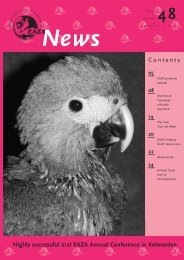EAZA NEWS 65 - European Association of Zoos and Aquaria
EAZA NEWS 65 - European Association of Zoos and Aquaria
EAZA NEWS 65 - European Association of Zoos and Aquaria
Create successful ePaper yourself
Turn your PDF publications into a flip-book with our unique Google optimized e-Paper software.
Thinking big<br />
Lech Banach, Director <strong>of</strong> Poznań Zoo<br />
Lech Banach reveals the thinking behind the new elephant building <strong>and</strong> exposition at Poznań Zoo.<br />
Elephants are animals which have always evoked a huge interest amongst<br />
visitors <strong>and</strong> are <strong>of</strong>ten the focal point <strong>of</strong> each visit to a Zoological Garden.<br />
After the death <strong>of</strong> Kinga, our old Asian female elephant, the people <strong>of</strong><br />
Poznań were immediately interested in having a new elephant, perhaps<br />
even a group.<br />
Because the elephant building, almost 120 years old, couldn’t ful� l its<br />
original purpose any longer, it was logical that a new building <strong>and</strong> expo<br />
had to be built. The location chosen was the New Zoo (Poznań has two<br />
Zoological Gardens: The Old Zoo <strong>and</strong> The New Zoo). That same year the<br />
<strong>Association</strong> for Friends <strong>of</strong> the Zoological Garden was established as well,<br />
its primary purpose being to build a new elephant habitat in Poznań.<br />
Two architects Rafał Mysiak <strong>and</strong> Piotr Poniatowski o� ered to prepare an<br />
initial design <strong>of</strong> the new complex for free. They got to work immediately,<br />
keeping in close contact with the directors <strong>of</strong> the Zoo, Lech Banach <strong>and</strong><br />
Radosław Ratajszczak.<br />
The main aim <strong>of</strong> the project was to ensure only the best conditions<br />
for elephants. Therefore, during the planning phase the architects took<br />
suggestions from many experienced elephant keepers into consideration.<br />
Since this was the � rst time the architects had ever designed such a<br />
complex the <strong>Association</strong> for Friends <strong>of</strong> the Zoological Garden organised<br />
trips to many di� erent <strong>European</strong> <strong>Zoos</strong>. This gave them the chance to see<br />
<strong>and</strong> learn about such habitats (Wuppertal, Koln, Tierpark, Berlin, Warsaw,<br />
Emmen, Rotterdam, Amneville, Munster).<br />
In the beginning <strong>of</strong> 2005, the <strong>Association</strong> for Friends <strong>of</strong> the Zoological<br />
Garden donated to the city a completed concept design as well as a part<br />
<strong>of</strong> a construction design which was 1/3 <strong>of</strong> the cost <strong>of</strong> the entire project.<br />
This design encorporated enough room for 5-6 female elephants <strong>and</strong><br />
their young as well as one male elephant.<br />
At � rst the City Council <strong>of</strong> Poznań was rather taken back by the idea <strong>of</strong><br />
building such a large complex in the Poznań Zoo. However, the unique<br />
<strong>and</strong> original architectural sphere that was presented in the project had<br />
a huge in� uence on the Council’s change <strong>of</strong> heart. Finally in June 2007<br />
construction began.<br />
Since the elephants must be kept indoors for periods <strong>of</strong> time each<br />
year do to harsh climate, it was decided that most <strong>of</strong> the building will<br />
be devoted to the animals themselves. Part <strong>of</strong> it has been designed to<br />
simply house the elephants. Within the building itself the largest indoor<br />
exhibit is accessible to the entire group. The male’s stable <strong>and</strong> individual<br />
ANIMAL HOUSING<br />
enclosures for the females will remain hidden from the public. With the<br />
technology provided it is possible to vertically close o� the females’ area<br />
to create eight individual enclosures.<br />
The vast majority <strong>of</strong> visitors come to the New Zoo from spring to<br />
autumn which is why there is relatively little space inside for viewing.<br />
We do believe that most <strong>of</strong> the year the majority <strong>of</strong> people will observe<br />
the elephants outdoors. There are two chief structures: the main area<br />
(2.5 ha) <strong>and</strong> an additional area (6ha). Such large structures were created<br />
to ensure the proper care <strong>of</strong> the elephants’ skin <strong>and</strong> feet. In addition, in<br />
order to limit severe damage to the ground <strong>and</strong> to allow the elephants<br />
to behave naturally, we plan to use each area <strong>of</strong> the facility alternately.<br />
This will allow the previous area used to be replenished.<br />
We wanted to make sure there was something for the visitors too, so<br />
an African Village with restaurants <strong>and</strong> co� ee shops was built next to<br />
the main exposition area. During the winter months people will be able<br />
to view the elephants indoors. A platform 3 metres above ground level<br />
was built for the visitors. The main hall used for educational purposes is<br />
located here as well. From the platform two ramps will exit from each<br />
side along the walls, one <strong>of</strong> which leads to another exit at ground level.<br />
All empty areas within the pavillion will be used for educational<br />
purposes, including many posters <strong>and</strong> billboards (some interactive).<br />
The gr<strong>and</strong> opening was in October 2008, <strong>and</strong> the entire complex will<br />
be ready by 2009.<br />
23

















